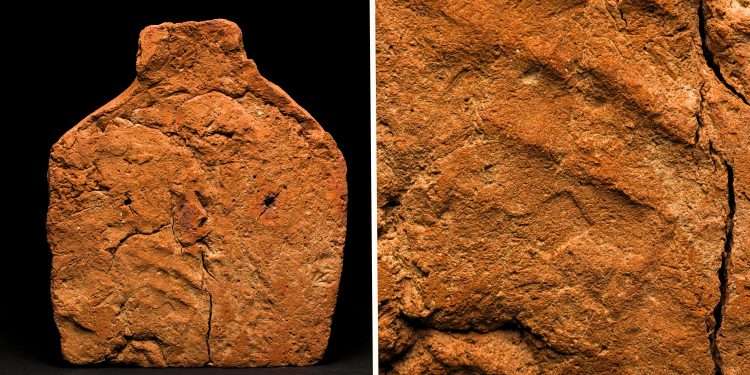4,000-Year-Old Handprint Found on Egyptian Artifact: A Touch Through Time
.Introduction: A Silent Mark From the Past
Archaeologists at Cambridge’s Fitzwilliam Museum announced a groundbreaking find when they discovered a 4000-year-old human handprint inside the base of a distinctive Egyptian clay artifact. A 4000-year-old clay print shows an unintentional mark left by an ancient potter working in Egypt during its Middle Kingdom period (circa 2055–1650 BCE). This artifact survived time to preserve an unmodified impression of an ancient craftsman who existed during that period.
The museum discovered this small yet significant human find in their storage facilities which now draws both experts and people who study history. This artifact stands beyond being a historical note because it represents a tangible imprint of a person who survived in ancient Egypt.
4,000-Year-Old Handprint Found on Egyptian Artifact
What Is a “Soul House”?
The artifact containing the handprint represents a clay “soul house” that functioned as a ritual model to depict a dwelling. The First Intermediate Period and Middle Kingdom of Egypt witnessed the frequent placement of these objects inside tombs and burial sites. The purpose of soul houses in ancient Egypt was to create spiritual houses for deceased souls (ka) who needed sustenance and symbolic protection along with symbolic shelter for their afterlife journey.
The objects resembled flat-roofed houses while featuring relief sculptures of doorways and courtyards and relief-sculpted offerings. These artifacts served as dual-purpose objects because they represented spiritual homes while functioning as altars for funerary rituals.
The handprint impression exists at the base of a soul house which dates back to 1900 BCE. According to museum curator Dr. Helen Strudwick the discovery of a complete visible handprint on such a Middle Kingdom artifact represents a new historical milestone.
The Discovery: Accidental Yet Monumental
The Fitzwilliam Museum prepares to display “Made in Ancient Egypt” in October 2025 as its upcoming exhibit. Museum staff started a thorough collection review as part of their exhibit preparation work which involved examining artifacts that had not received close study in many years. The curators discovered an unusual hand print on a clay soul house during their examination of museum artifacts.
The forensic analysis proved that the print came from a human hand which probably belonged to the artisan who manufactured the object more than four thousand years ago. The clay imprint shows evidence of being formed when the potter accidentally applied his or her hand onto the clay before firing the vessel.
The moment which appears in terracotta reveals to contemporary observers an unbroken link to someone who lived many centuries ago. This imprint belongs to an ordinary person who was a ritual object maker at his workshop in ancient times.
Historical Context: Egypt’s Middle Kingdom
The handprint belongs to the Middle Kingdom period of ancient Egypt (2055–1650 BCE) which historians consider the “classical age” of Egyptian culture. The period succeeded the First Intermediate Period and brought strong central authority together with large-scale architectural developments and artistic and literary growth and religious resurgence.
During this time, tomb architecture evolved significantly. The elite population transitioned away from stone pyramid construction to create personal burial sites containing everyday artifacts such as bowls, food models and tools along with figurines and soul houses. The items demonstrated the religious belief that deceased people needed food and housing to survive after death.
https://anonymouswire.com/air-pollution-dementia-risk-cambridge-study-2025/
Soul houses featuring their household elements and offerings demonstrated the cultural transformation toward individualized funerary objects. The spiritual nature of the object combined with normal workshop practices made the discovery of the artisan’s handprint even more emotionally powerful.
The discovery of this ancient artefact provides a rare opportunity to view the humanity of these ancient individuals.
The clay soul house, especially the handprint, offers an entirely new perspective because it differs from statues and hieroglyphs made to honour royalty. The fingerprints left by these ancient people alongside their mistakes and touching of surviving artifacts tell us much about their similarity to us.
Dr. Strudwick says that most of us study ancient Egypt through the study of kings, temples and pyramids. This print serves as evidence of a real person who may never have been recorded by name while leaving behind their fingerprints in the most direct manner.
It is a significant illustration of intimate archaeology, a term that refers to the process of uncovering personal stories instead of just facts.
Why This Matters in 2025
We still find meaning in our archaeological work today as we use technological methods like LIDAR scans, AI modelling, and satellite imaging to examine this ancient artifact which reveals the reason we study history in the first place. It is not for seeking treasure or fame but to establish a connection with the past.
The 4,000-year-old handprint will be the main attraction at the “Made in Ancient Egypt” exhibition that will start this October and continue until April 2026. The handprint will be presented as both an artifact and as a representation of how ancient humans touched our modern lives.
Conclusion: One Handprint, Endless Echoes
The small, unintended handprint could be considered one of the most emotionally significant archaeological discoveries of the year. This discovery does not contain gold or hieroglyphs or an elaborate sarcophagus but instead presents the unspoken touch of a human hand on wet clay.
Historical connection appears distant to us in modern times until this discovery brings us closer so we can see the palm of the past through history instead of history itself.

